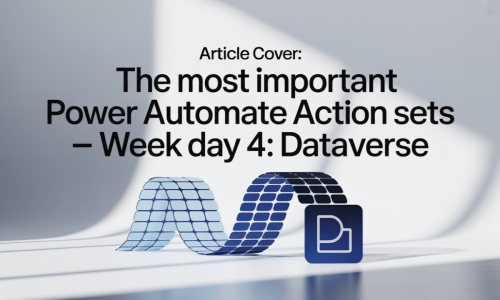The Most Important Power Automate Action Sets – Week Day 7: HTTP / Premium Connectors

-
Admin Content
-
Oct 27, 2025
-
296
Why HTTP and Premium Connectors Are a Big Deal
When you're working with Power Automate, connectors are your bridge to the outside world. They enable flows to interact with other apps, databases, platforms, and services—whether inside or outside the Microsoft ecosystem. Among these, HTTP connectors and premium connectors stand out for one simple reason: they give you maximum flexibility and reach.
Premium connectors (like HTTP, Azure DevOps, and Office 365 Groups) are behind the paywall, but they unlock some of the most powerful automation capabilities Power Automate has to offer. HTTP connectors, in particular, let you work directly with APIs—whether REST, SOAP, or even GraphQL—giving you access to countless integrations that aren't covered by standard connectors.
In short, these connectors take Power Automate from a "simple tool for Microsoft apps" to a full-blown enterprise-grade integration engine.
The Main HTTP / Premium Connectors in Power Automate
According to David Wyatt’s detailed rundown, there are eight HTTP-style connectors you should be aware of. These include both generic and app-specific variants:
HTTP Connector (Generic)
This is the most flexible connector. It allows GET, POST, PUT, DELETE, and other HTTP methods. You can use it to interact with nearly any web service, provided you can handle the headers, body, and authentication manually. It supports various auth types, such as:
- No authentication
- Basic authentication
- OAuth 2.0 (client credentials)
However, one critical drawback: credentials like client secrets and passwords are exposed in plain text. This makes the HTTP connector unsuitable for production scenarios where security is critical. Instead, it should be used for development or open APIs.
SharePoint HTTP Connector
Although there's a SharePoint connector, the HTTP version is useful for accessing advanced endpoints, such as:
- /_api/web/lists/getbytitle('ListName')/items
- CSOM (Client-Side Object Model) operations
- Hidden metadata
This lets you bypass limitations in the standard SharePoint connector.
Outlook and Office 365 Users/Groups
These connectors let you work with:
- Mailboxes (send, read, or forward emails)
- Calendars
- Group membership info
- Organizational hierarchies
Using HTTP variants of these services gives you access to Graph API endpoints, which allow granular control over email headers, calendar filters, and user properties.
Azure DevOps & Azure AD
These connectors are used to:
- Create work items
- Assign tasks
- Fetch user permissions
- Manage security groups or repositories
Again, the HTTP variant lets you tap into more advanced endpoints beyond the UI, like REST calls to the Azure DevOps API for pipelines, builds, and pull requests.

Real-World Use Cases and Integration Scenarios
These connectors open the door to endless automation use cases, especially in enterprise environments:
Working With External APIs
Need to integrate with a CRM that doesn’t have a Power Automate connector? The HTTP action can send POST requests directly to their API to:
- Create leads
- Update contact records
- Trigger workflows
Cross-Platform Automation
Use HTTP connectors to bridge platforms like:
- Power Automate ↔ Slack via incoming/outgoing webhooks
- Power Automate ↔ Jira (e.g., to open tickets)
- Power Automate ↔ Payment gateways (e.g., Stripe API)
This is especially useful when building custom enterprise solutions across disparate systems.
Managing Security and Compliance
Use Azure AD HTTP requests to:
- Auto-provision users
- Assign roles dynamically
- Audit group memberships
For example, you can run a weekly flow that checks if anyone in a sensitive group hasn't logged in recently, and flag it for review.
Dealing with Legacy Systems
When dealing with internal APIs from legacy systems, often only HTTP access is available. The HTTP connector allows you to:
- Query internal databases via REST endpoints
- Trigger legacy workflows
- Generate reports in older formats
Licensing, Costs, and Limitations
Power Automate doesn’t offer all these goodies for free. Here's what to keep in mind:
Premium Licensing Required
HTTP actions and connectors like Azure DevOps, Office 365 Groups, and Azure AD are premium features. They require one of the following:
- Power Automate Per User Plan
- Power Automate Per Flow Plan
- Power Platform Licenses via Dynamics or Office 365 (limited)
If you’re using a free or basic tier, these connectors will be unavailable.
API Call Limits
Each license has API call limitations, usually measured per 24 hours. For example:
- Power Automate per user: 5,000 API calls/day
- Power Automate per flow: 15,000 API calls/day (shared)
Frequent HTTP requests, especially in loops, can burn through your quota fast.
Security Considerations
As mentioned, sensitive data in the HTTP connector is stored in cleartext within the flow. To maintain security:
- Use environment variables
- Consider Custom Connectors with OAuth
- Limit access to secure flows via solution environments
Best Practices When Using HTTP & Premium Connectors
Whether you’re building your first HTTP-enabled flow or a complex enterprise workflow, follow these tips:
Use Environment Variables for Secrets
Avoid hardcoding secrets into your flows. Use Azure Key Vault, environment variables, or dataverse tables to store secrets securely.
Create Reusable Child Flows
Instead of repeating the same HTTP logic across flows, build a child flow for calling APIs. Then use the "Run a Child Flow" action to reuse it anywhere.
Use Retry Policies & Timeouts
APIs fail. Add retry policies and reasonable timeouts to handle flaky endpoints or slow APIs gracefully.
Always Log Failures
Add custom logging to monitor:
- Failed HTTP calls
- Invalid responses
- Auth errors
Use tools like Application Insights, Dataverse logs, or even a dedicated SharePoint list.
Switch to Custom Connectors When Needed
If you frequently interact with a specific API, build a Custom Connector. It supports proper OAuth handling and hides secrets from plain view, unlike the HTTP connector.
Wrapping Up: HTTP Actions as Your Automation Power Tool
HTTP and premium connectors are not just optional bells and whistles—they’re essential tools for anyone trying to build serious automations with Power Automate. They’re your keys to working with internal systems, third-party APIs, cloud platforms, and everything in between.
While licensing, security, and rate limits are valid concerns, they’re easily manageable with the right planning and architecture. If you're ready to go beyond the basics and start building truly enterprise-grade flows, mastering these connectors is where you start.








